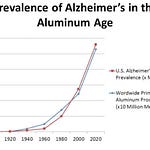For new readers: HERE are links to download my CV, ebooks, the best recent posts, and how to search my archives. Thank you for your reviews of Judas Dentistry. HERE is the direct link for that.
My friend Jerome Kahn supplied most of the ideas and references here. Robert Yoho abridged, edited, and organized it. Please read the entire post before you judge whether the Pharma companies are as evil as we say.
Aspirin is a safe and profoundly beneficial drug
Taking it daily at modest doses lowers the risk of developing cancer by over 50 percent. It also lowers the risk of dementia, diabetes, and heart attack. Hundreds of journal articles testify to these benefits and more. It is over-the-counter and sells for under five cents a dose.
In 1980, Bayer’s aspirin had been the number-one-selling drug for over five decades. If physicians had read the literature and known of its virtues, it would have cut many Pharma companies' profits in half.
Pharma’s “tobacco ethics” are unimaginable to the rest of us, even now during the covid era. In World War II, Bayer was a subsidiary of IG Farben, which used slave labor in factories in German-occupied Auschwitz, Poland, and elsewhere. It manufactured Zyklon B, the gas used to kill Jews and others. The company’s strategy is to foster illnesses that could be treated with the “cures” they supply.
Their companies used “tobacco science” to replace aspirin, a wonder drug, with toxic Tylenol (APAP) as the top-selling medication. They profit from adverse effects and sometimes from fatalities. They sell wellness but cause illness, (References: Dr. Yoho’s Butchered by Healthcare and his podcast about fluoroquinolones.)
The Harvard Nurses and the FULL studies showed that taking a single uncoated 325 mg aspirin daily for several years reduces the risk of cancer by over 50%. The chances of stage I, II, and III becoming the deadly stage IV also declined, and the overall survival rate improved by 64 percent. Aspirin does this by turning up the body’s self-healing powers, such as using apoptosis to dismantle abnormal cells without releasing harmful reactive chemicals.
Besides its cancer effects, aspirin reduces the risk of a heart attack by 44%, and also the chances of dementia, diabetes, fibrosis of the lungs, multiple sclerosis, Parkinson’s, Alzheimer’s, ALS, strokes, and life-threatening pulmonary embolism. Infections with fungus, bacteria, and viruses decline as well.
Established literature suggests that long-term aspirin usage reduces gout, fatty liver, mental illness, inflammation, hypertension, obesity, osteoporosis, insulin resistance, atherosclerosis, endothelial dysfunction, macular degeneration, metabolic syndrome, oxidative damage, and rheumatoid arthritis. Both cellular mechanisms and large population studies support all these effects.
Baby aspirin was invented to prevent the decline of profitable diseases that result from taking conventional doses of 325 mg daily. Read the entire article before you stamp this as hyperbole.
A 1993 study of a decade of 600,000 Canadian health records showed a 60% cancer risk reduction for those taking five or more aspirin a week.
Aspirin is not a poisonous chemo drug that destroys function but a profoundly beneficial substance. It is a natural plant product that is theorized to have co-evolved with mammals. Plants make salicylic acid, and our body’s natural processes convert benzoic acid into salicylic acid. This has many uses.
Bayer improved it by adding acetic acid to make acetylsalicylic acid and marketed it in 1899 at a 500 mg dose. It became the go-to drug for pain, colds, and arthritis.
Aspirin protects adenosine triphosphate (ATP), our body’s biofuel, and its source, mitochondria, which are involved in self-healing processes. ATP provides 95% of the energy for our biological processes, including producing hemoglobin and muscle contraction. It helps mitochondria produce ATP, which improves health.
These basic facts are poorly recognized, for our educational systems and media have swindled us. Using scientists for hire, Pharma has become our teacher, and our ignorance increases their profits. For 80 years, aspirin was the leading drug for pain, colds, and arthritis. But its sales were gutted to profit drug companies, and it was purposefully replaced with toxic Tylenol.
Baby aspirin at 81 mg is far less than a therapeutic dose. Many people take vitamin pills daily for health, but few take the standard dose of 325 mg of uncoated aspirin daily.
325 mg of uncoated aspirin daily turns up healing and reduces biological stress
Aspirin lowers the incidence of dementia in Alzheimer’s, Parkinson’s, ALS (amyotrophic lateral sclerosis,) and other neurological syndromes. It increases brain-derived neurotropic factors (BDNF), which promotes healing, and it slows amyloid creation.
Aspirin is an anticoagulant that lowers the incidence of strokes, heart attacks, and pulmonary embolism.
Aspirin inhibits the growth of Helicobacter pylori, which is the cause of ulcers.
Aspirin is an antioxidant, which protects cells and their mitochondria from non-enzymatic reactive chemical bonding or oxidation.
The Harvard Nurses’ Study showed a 67% reduction in breast cancer deaths in stages I, II, and III compared to controls when aspirin was used daily for six weeks. No chemotherapy compares. Yoho comment: chemotherapy effects on breast cancer are nominal, if any.
Aspirin reduces cancer: 63% colon, 36% lung, 39% prostate, 73% esophageal, 62% stomach, and 55% for melanoma. The mechanism is thought to be apoptosis of abnormal cells. Those numbers would likely be even higher if a 325 mg uncoated tablet were used twice daily. (Some references do not specify the dose or whether an enteric coating was used.)
Diabetes type 2 cured: Case reports of diabetes cures have been reported after five grams per day for two weeks, and 325 mg daily reduces its risk. Read about the mechanism HERE.
Arterial endothelial dysfunction is believed to cause cardiovascular disease. Aspirin prevents this, and the mechanism is thought to be bacteria entering arteries and then colonizing the inner layers to form plaque. (Citation: Aspirin Protects Endothelial Cells From Oxidant Damage Via the Nitric Oxide-cGMP Pathway).
The lungs, liver, brain (glia), heart, and other tissues can become fibrotic, It is a serious condition that can cause fatality. Aspirin reduces this by promoting self-healing.
Aspirin reduces cardiac events. When taken every other day for five years, it reduced unstable angina by 236%. This study involved 22,071 U.S. physicians (a review reference is HERE), and their patients’ ulcer rates were unchanged whether they took aspirin or not. Jerry Kahn: I have taken two 325 mg uncoated aspirin a day for the last 32 years and have never had heartburn.
Leaking coronary plaques are thought to cause heart attacks due to the formation of fibrous clots that close arteries. Aspirin lowers the amount of fibrinogen, which is thought to prevent this.
Hypertension is the major cause of atherosclerosis, and aspirin decreases its progression. Pharma claims that the muscles in the artery wall cause high blood pressure, so their patent drugs block them with catecholamine muscle relaxants. This weakens the heart, which is thought by some to increase deaths.
Aspirin decreases the incidence of certain infections: “Aspirin and salicylate inhibited the growth of H pylori in a dose-dependent manner, and bactericidal activity was due to cell lysis.” This bacteria causes ulcers.
Aspirin decreases insulin resistance in diabetes. This makes insulin work better. Insulin has at least 16 regulatory functions. “We show that high doses of salicylates reverse hyperglycemia, hyperinsulinemia, and dyslipidemia” (high glucose, high insulin, and high blood cholesterol). “Chronic aspirin administration completely reversed glucose intolerance and decreased the oxidative status.” Aspirin lowers blood glucose and insulin resistance, which is thought to improve mitochondrial function.
Experiments have shown that aspirin extends the median lifespan of the worm C. elegans by 25%. Median lifespan was also increased in mice given aspirin.
Aspirin lowers mitochondrial dysfunction, insulin resistance, and oxidative stress. Some speculate this explains its positive effects on mental illness.
“Aspirin lowers or prevents demyelination of neurons in MS… There are several advantages of aspirin over other available therapies for MS.”
Aspirin reverses osteoporosis and promotes positive bone remodeling. “Aspirin can inhibit osteoclast differentiation and bone resorption activity in a dose-dependent manner, thus exerting its anti-osteoporosis effect… Aspirin is emphasized as the drug of choice.” Other references are HERE, HERE, and HERE.
Aspirin decreases oxidative stress and has many other related benefits.
Giving twelve hundred mg of aspirin following major general surgery reduced pulmonary embolism from 15.4% to 6%; similar improvements were seen with total hip surgery and total knee replacements.
For rheumatoid arthritis, sodium salicylate and aspirin are equally effective. “The majority of patients with rheumatoid arthritis can be controlled with salicylates alone… it is the standard which all rheumatoid arthritis medications should be measured” Goodman and Gillman Pharmacology 11th Edition (2005), p 690. The Merck Manual (1987), p 960, recommends a dose “from 3 to 7.5 gm, the average 4.5 gm” for rheumatoid arthritis. This high dose was used for decades by millions. Note that this last source was published before the patented Motrin was first sold in the US (1974) and prior to its widespread adoption.
Stroke neuroprotection: “Aspirin is preventive against stroke not only because of its antithrombotic properties but also by other direct effects.” Other references showed neuroprotective effects in stressed rats. and another study cut off blood flow to rats’ brains and found that aspirin limited damage.
Pharma destroyed aspirin’s reputation
The massive Physician Health Study published in 1989 proved that aspirin usage protected the heart. 22,071 physicians participated, and the average patient follow-up was 60.2 months. Half of them took 325 mg every other day, and the other half took none. The aspirin group had 254.8 heart attacks per 100,000 per patient-year, and the placebo group had 439.7.
The placebo group had 138 ulcers, and out of the entire 11,075 people in the study, the aspirin group had 32 more. Over the study period of five years, the risk increased by 0.003 percent. Pharma then published an endoscopic study that claimed more “lesions” were seen in the stomachs of aspirin users. They trumpeted these “study findings” and claimed the ulcer hazard was 1,000 times greater when using aspirin. With the help of their paid-off FDA, this “data” was used to justify putting an ulcer warning even on .coated baby aspirin.
Before that, aspirin doses of 3.5 grams and above had been used for decades as the standard treatment for rheumatoid arthritis. Clinical experience with tens of millions of people had proven it safe, and no warning was required before 1980.
Pharma concocted the 81 mg coated baby aspirin to prevent these supposed ulcer risks. This takes hours to dissolve; the peak blood level went from 2 hours to 8.9 hours and was 50 percent lower. It was a therapeutic fraud, and its effects, if any, were unmeasurable. FDA has also said—accurately—that baby aspirin doesn’t lower the risk of cancer and—a lie—that aspirin should not be taken to prevent cancer.
In another attack on aspirin’s credibility, Reye’s syndrome was claimed to be related to aspirin use in children. It was first reported in 1963 by pathologist Douglas Reye and had a death rate of about 20 percent. Because of this, the recommendation to use aspirin for children was withdrawn.
Reye’s is rare. The diagnosis was initially fashionable—555 cases were reported to the CDC in 1979-80. However, by 1987, this number had declined to 36 cases. The diagnosis was based on symptoms, but when a genetic test was developed, only two cases per year were seen in the entire US. This fact disappeared from Wikipedia about 15 years ago. A comprehensive review published in 2012 concluded, “Effect relationship between aspirin intake and Reye syndrome in children is not supported by sufficient facts.”
The Reye’s ploy worked despite the frauds. After the lapdog FDA began warning parents about aspirin, few of the next generation took it or gave it to their children.
The assault on aspirin continued with claims of allergy and toxicity. Wieth the ulcer risk as the excuse, the FDA said that baby aspirin should only be used for those with the highest risk of heart attacks and not for cancer prevention. An aspirin bottle has 15 lines of warnings; this should be 15 lines of benefits.
Physicians remember what Pharma companies and the FDA have beaten into their brains. Few have the time or background in criminal behavior analysis to dissect the lies.
Jerry Kahn: I have been taking 650 mg daily or more since 1993 when my doctor prescribed 3,500 mg daily (eight 325 mg) for my chronic back pain. This was the standard treatment in the pharmacology textbooks and The Merck Manual in 1992 and before. I am 81, my back is pain-free, and I run about 60 miles a month.
Yoho: As recently as five years ago, I authoritatively told people that taking a baby aspirin a day was a break-even between decreasing the risks of heart attacks and increasing bleeding.
Pharma promoted toxic phenacetin, then toxic Tylenol
Tylenol (acetaminophen, APAP, N-acetyl-para-aminophenol, paracetamol) is a painkiller that reduces fever. Phenacetin is a closely related compound. Unlike aspirin, these drugs have no anti-inflammatory effects.
These were first synthesized in the late 1800s, and phenacetin was marketed first because APAP (later dubbed Tylenol) was thought too toxic. Phenacetin was withdrawn from the US market because it caused kidney damage, so Pharma responded by turning APAP into a bestseller.
Toxicity
“Acetaminophen toxicity is the second most common cause of liver transplantation worldwide and the most common cause of liver transplantation in the US. It is responsible for 56,000 emergency department visits, 2,600 hospitalizations, and 500 deaths per year in the United States.” (Other sources: 1000 deaths).
Aspirin is far less toxic; fatalities require high doses and are rarely reported.
Tylenol is the leading cause of drug death from liver failure Taking just four grams (eight 500 mg capsules) of Tylenol in 24 hours may cause slow, agonizing fatal liver necrosis. When combined with alcohol, this may occur after only two grams (four pills). For survival, survive, treatment must begin within about eight hours.
Jerry: My uncle was taking Tylenol and was later prescribed Percocet, a Tylenol/opioid combination. The continuous acetaminophen caused his liver to shut down, and he spent eight days in the hospital.
Bayer introduced phenacetin in 1887
It was born out of the need to dispose of 30,000 pounds of para nitro-phenol, a substance Bayer used for dyes. They marketed it into a global success.
Phenacetin studies on animals uncovered multiple side effects, including cancer and renal disease. It was learned in 1948 that the body converts phenacetin into APAP (Tylenol), which was considered at the time too toxic to market. It took another 25 years for Canada to ban phenacetin (1973) and 35 years for the U.S. to do the same. APAP should also have been banned, but instead, it remained over-the-counter.
A study measuring the liver enzyme alanine transaminase (ALT) found that 39% of users experienced an elevation to more than three times normal when they took four grams of Tylenol (eight 500 mg capsules) a day. After 14 days, a quarter of them had ALTs that were eight times the upper limit of normal.
A long-term study found a 63% increase in the death rate in regular users of APAP. “There is a consistent association of increased mortality as well as cardiovascular (stroke, myocardial infarction), gastrointestinal (ulcers, bleeding) and renal adverse effects with taking higher dose of paracetamol… It is now the most commonly used analgesic in the world” (from Wikipedia 2011 and Jan 2024).
APAP is a neurotoxin. A study of the elderly found the proportion with dementia who used APAP was 50.6% compared to 21.4% who did not take it. Alzheimer’s is a pandemic, and may be related to this.
A study of 2.919 Norwegian mothers looked at Tylenol use during two of their pregnancies, one with the drug and another without it. To reduce confounding familial and genetic factors, same-sex siblings were compared. The mothers who used APAP for 28 days or longer during pregnancy had offspring whose cognitive function was statistically lower than their siblings. Other studies confirmed this. Studies on pregnant rats are further support for APAP’s neurotoxicity.
A three-fold increase in children’s asthma was seen when they were given APAP by their seventh year. Another source documented a 323% increase. Cognitive and physical developmental decline were also linked.
Human studies show that APAP increases diabetes by 20 percent or more in long-term users.
At therapeutic dosages, acetaminophen can be kidney toxic for patients who are glutathione-depleted or who are taking drugs that stimulate liver P-450 microsomal oxidase enzymes.
APAP causes mitochondrial dysfunction: “These findings indicate that paracetamol toxicity results in an impairment of mitochondrial function which precedes the loss of blood membrane integrity.”
By 2023, Tylenol had been added to over 100 prescription medicines. When this is done using an off-patent drug, the new combination can be patented. By 2011, there were 325 over-the-counter preparations containing it (CDC figure). Marketing through physicians has made APAP the leading NSAID; it replaced aspirin over 30 years ago.
Pharma profits from complications and even deaths. As hard as it is to believe for normal people, APAP might be a first-choice additive because of its harms.
I (Jerry) get a general malaise after taking just one Tylenol. My neighbor Don died of kidney failure in 2022. He took daily opioids combined with APAP for his severe arthritis. Few physicians appreciate how dangerous the drug is.
Even academics say Tylenol is toxic
This is the abstract from a 2018 review titled, Long-term adverse effects of paracetamol – a review:
Paracetamol (acetaminophen) is the most commonly used drug in the world, with a long record of use in acute and chronic pain. In recent years, the benefits of paracetamol use in chronic conditions have been questioned, notably in the areas of osteoarthritis and lower back pain. Over the same period, concerns over the long-term adverse effects of paracetamol use have increased, initially in the field of hypertension but more recently in other areas as well. The evidence base for the adverse effects of chronic paracetamol use consists of many cohort and observational studies, with few randomized controlled trials, many of which contradict each other, so these studies must be interpreted with caution. Nevertheless, there are some areas where the evidence for harm is more robust, and if a clinician is starting paracetamol with the expectation of chronic use, it might be advisable to discuss these side effects with patients beforehand. In particular, an increased risk of gastrointestinal bleeding and a small (~4 mmHg) increase in systolic blood pressure are adverse effects for which the evidence is particularly strong and which show a degree of dose dependence. As our estimation of the benefits decreases, an accurate assessment of the harms is ever more important. The present review summarizes the current evidence on the harms associated with chronic paracetamol use, focusing on cardiovascular disease, asthma and renal injury, and the effects of in-utero exposure.
References and comments supplied by Polymath Paul
Make sure your Aspirin is uncoated; powder is even better.
"If a newly discovered substance had aspirin’s antiinfective, anticancer, antistress, antioxidant and antiinflammatory actions it would be the most researched substance in history." — Ray Peat (2013)
https://www.toxinless.com/aspirin
https://www.toxinless.com/
https://raypeat.com/articles/aging/aspirin-brain-cancer.shtml
https://www.functionalps.com/blog/2012/04/22/ray-peat-phd-on-aspirin/
https://www.functionalps.com/blog/2011/08/15/protective-benefits-of-aspirin/
Other references from Jerome Kahn’s website
Heart attacks: /rc/id17.
Three pages of videos and 500 documentaries on 23 health topics, economics, and related topics: /rc/id22
I wrote three articles on aspirin’s benefits for http://healthfully.org/rc. These cite 200 journal articles. Seventy other articles on aspirin and other NSAIDS are on my website HERE and HERE. These expose Pharma and their captive FDA. (Yoho: If some of these pages are blocked, enter the URLs into the Wayback Machine’s search bar to find them.)
For a thorough search of the journals on toxic APAP, go to http://healthfully.org/rc/id5.html. In a better world, aspirin would be the top seller, and APAP would never have been marketed.
Yoho note:
I am once again stunned by my peers’ and my own credulity. I am also amazed at how resilient humans are in the face of this and other purposeful poisonings. Few of us dropped dead because of all this until the corona “vaccine.”













Share this post